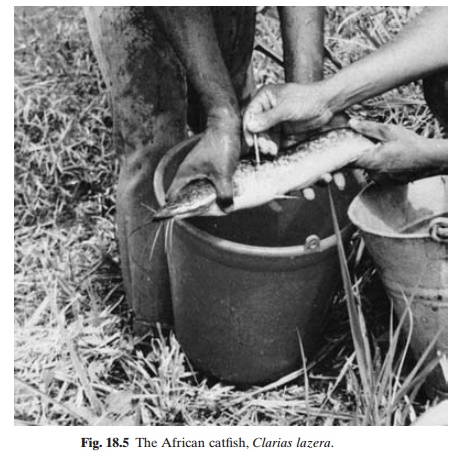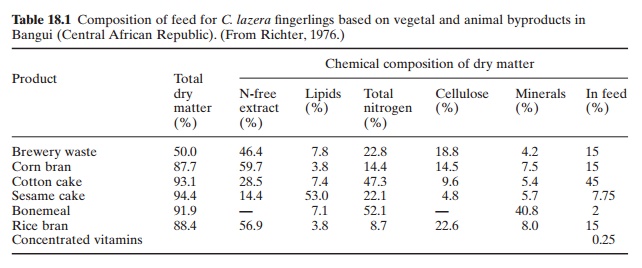Chapter: Aquaculture Principles and Practices: Catfishes
Grow-out and feeds of African catfish
Grow-out and feeds
Since most of the research efforts on C. lazera have been directed towards developing methods of spawning and rearing of fry, there are only limited data available on commercial grow-out procedures. In rural fish culture, the fish normally live on the natural productivity of the ponds, which may be enhanced by the addition of small quantities of fertilizers. In recent years, attempts have been made to grow pigs or ducks in association with fish ponds, as pig manure and duck droppings add considerably to the productivity of the ponds.

In Central African countries, the fish have been reared in ponds heavily fertilized with pig manure and fed on different locally available feedstuffs. Brewery waste and peanut cake areused as the main supplementary feed in some centres. Table 18.1 shows the composition of a diet used to determine the growth rate of fingerlings (9g weight), stocked at densities in the range 1–10 per m2 (Richter, 1976). The results showed that growth and feed conversion with pelleted feeds containing vegetable products were very satisfactory at stocking densities of two fish per m2. The fish grew to an average weight of 600g in about 200 days. The estimated production was in excess of 12 tons/ha per year.

It has been found that the African catfish seldom make use of demand feeders, and hand feeding is the most practical feeding method. It has also been observed that the males grow much faster than females. De Kimpe and Micha (1974) found that in four months’ rearing, the males attained a weight of 427g, while the females reached a mean weight of only 292g.
In integrated farming with pigs, catfish of 95g mean weight, stocked at the rate of one fish per m2, grew to over 380g in 4.5 months’ rearing, giving an annual yield of 7 tons/ha.
While the high potential of C. lazera (= gariepinus) has been demonstrated both in pond culture and in intensive tank culture, recirculation systems have been found to be more effective than flow-through systems for intensive culture, owing to the tolerance of the species to the high ambient temperature and high stocking density (Bovendeur et al., 1987; Huisman and Richter, 1987).
Although a number of parasites have been identified from C. lazera, mortality due to major infections has not been reported. Trichodina infestation of fry has been observed in ponds and this can be controlled by treatment with 50ppm formalin for about an hour.
Related Topics